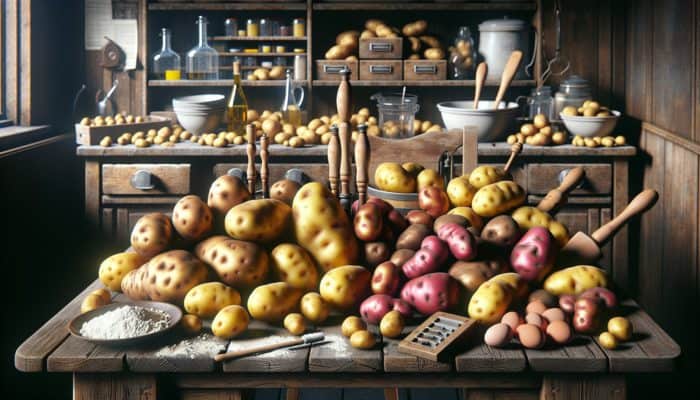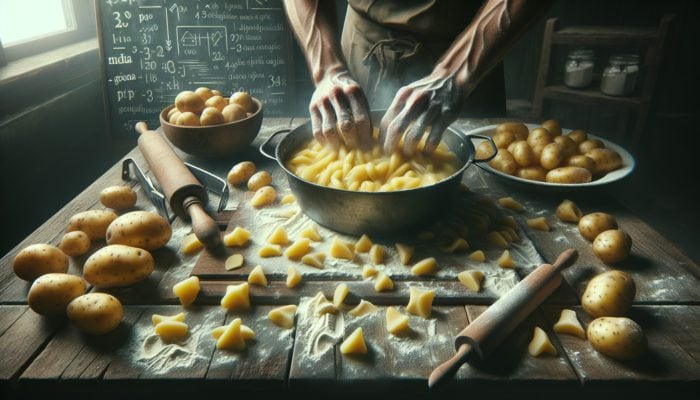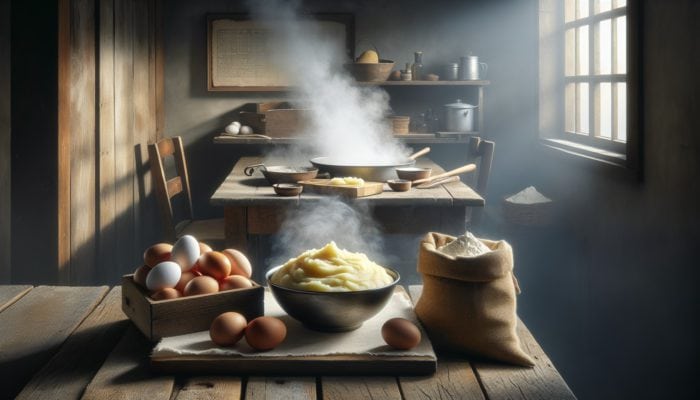Key Elements for Creating Light and Fluffy Gnocchi at Home
How to Select the Best Potatoes for Light and Fluffy Gnocchi

Starting the wonderful adventure of crafting homemade gnocchi begins with the essential selection of potatoes. For the best outcome, opt for starchy varieties such as Russets or Yukon Golds, renowned for their high starch content. This characteristic is crucial as it contributes to achieving a light and airy texture in your gnocchi. When boiled, these types of potatoes yield a tender consistency that mashes easily, leading to a dough that is both workable and fluffy. It’s imperative to steer clear of waxy potatoes like Red Bliss or new potatoes, as these contain more moisture and less starch, resulting in denser and heavier gnocchi that do not achieve the desired lightness and texture.
Once you have selected your potatoes, examine them carefully to ensure they are firm, blemish-free, and devoid of sprouts. The quality of your potatoes significantly impacts the final outcome, so always choose fresh, high-quality options. Many culinary traditions advocate for using recently harvested potatoes, as they bring a fresh essence to the dish that older varieties cannot replicate. Your potato selection may also reflect various regional culinary techniques, spanning from traditional Italian gnocchi to innovative South American adaptations, highlighting a universal appreciation for this versatile dish.
Understanding the Vital Role of Flour in Gnocchi Preparation
When it comes to flour, all-purpose flour is the go-to choice for crafting the perfect gnocchi. It strikes an optimal balance between gluten content and structural integrity, ensuring that the dough holds its shape during cooking without becoming overly dense. For those with gluten intolerances, alternatives like chickpea flour or gluten-free blends can serve as suitable substitutes, though the resulting texture and flavor may differ from traditional recipes, necessitating some experimentation.
The ratio of flour to potato is critical for achieving the ideal texture. A standard guideline is about one cup of flour per medium potato; however, this can vary based on the moisture content of your potatoes. Gradually incorporating flour while mixing is essential, ensuring the dough reaches a soft yet non-sticky consistency. This careful method guarantees that your gnocchi remain light and fluffy, avoiding a gummy texture. In some culinary regions, adding semolina flour can introduce a unique texture, reflecting the rich diversity of gnocchi-making traditions around the globe.
Improving Gnocchi Dough Texture with Egg Addition
Incorporating an egg into your gnocchi dough serves not only as a binding agent but also enhances the flavor and texture of the finished product. The moisture provided by the egg contributes to a tender and cohesive dough that is easier to shape into the signature pillowy forms. This technique is commonly found in traditional recipes from northern Italy, where the use of eggs is prevalent to elevate the dish’s quality and richness.
If you are searching for a vegan substitute or prefer to avoid eggs, consider options like flaxseed meal or aquafaba, although it’s important to note that the texture may vary. It’s crucial to assess how any alterations to the recipe may influence the overall moisture content and texture of your gnocchi. Understanding the purpose of each ingredient is vital for mastering the art of making homemade gnocchi easily.
Effectively Preparing Potatoes for Gnocchi Creation

Boiling Potatoes to Achieve the Ideal Gnocchi Texture
Commence your gnocchi-making process by boiling whole, unpeeled potatoes. This method is advantageous as it helps retain moisture, resulting in a fluffier texture that is vital for creating delightful gnocchi. Ensure the potatoes are boiled until they reach tenderness and can be easily pierced with a fork. Depending on their size, this boiling process can take between 20 to 40 minutes. It’s crucial to keep a close eye on them to prevent overcooking, which may lead to waterlogged potatoes and, consequently, gummy gnocchi that compromise the quality of your dish.
This boiling technique has been cherished through generations and is practiced across various culinary traditions. For example, some regions in Italy recommend steaming the potatoes instead of boiling them to preserve their natural flavors and textures. Regardless of the method you choose, remember to peel the potatoes while they are still warm. This practice simplifies the peeling process and ensures a smooth mash, free of lumps that could disrupt the texture of your gnocchi.
Mastering the Art of Mashing Potatoes for Gnocchi
The next crucial step is to thoroughly mash the boiled potatoes to create a smooth, lump-free base for your gnocchi dough. Utilizing a potato ricer or a traditional masher can effectively achieve this goal, but the aim is to reach a silky consistency. Engaging in the mashing process can be quite therapeutic, allowing you to connect with the ingredients and appreciate the nuances of your dish. It’s important to act quickly, as warm potatoes absorb flour more efficiently than cold ones, facilitating a smoother mixing process that yields the best results.
Many chefs recommend passing the potatoes through a sieve after mashing to achieve an ultra-smooth texture, which can elevate your gnocchi to a refined level sure to impress your guests. Remember, the smoother your mashed potatoes, the smoother your final gnocchi will be, leading to a mouthfeel that enhances the overall dining experience.
Cooling Mashed Potatoes for Effective Ingredient Integration

After mashing, allowing the potatoes to cool slightly before mixing in the egg and flour is vital. This cooling period prevents the egg from cooking, which could adversely affect the texture and moisture content of your gnocchi, leading to unsatisfactory results. Allowing the potatoes to cool also promotes better integration of the ingredients, resulting in a cohesive dough that is easier to work with.
Often underestimated, this step is one of the most critical aspects of making homemade gnocchi easily. By dedicating time to this practice, you not only enhance the final product but also demonstrate a clear understanding of how each component interacts throughout the cooking process. Consider this a moment to reflect on the balance of your ingredients, paving the way for the creation of gnocchi that truly embodies the beauty of your culinary journey.
Creating the Perfect Gnocchi Dough
Combining Ingredients to Form a Unified Gnocchi Dough
Creating the dough marks a pivotal milestone in your gnocchi-making journey. Begin by blending the warm, smooth mashed potatoes with all-purpose flour and a beaten egg. It’s beneficial to create a well in the center of the potatoes, gradually adding the flour and egg. This method allows you to more accurately assess moisture levels, ensuring that your dough achieves the desired consistency. The mixture should come together into a soft, pliable dough that is neither overly sticky nor too dry, striking that essential balance for successful gnocchi.
During mixing, feel free to use your hands or a wooden spoon; however, many traditional cooks prefer the tactile experience of using their hands. This connection to the food can be profoundly rewarding, allowing you to sense the texture of the dough as it transforms from a mixture of ingredients into an elegant, cohesive dough. It’s crucial not to overwork the dough, as this can lead to excessive gluten development, resulting in denser gnocchi that lack the desired lightness.
Gently Kneading Gnocchi Dough for Lightness and Texture
Once the dough has combined, it’s time to knead it gently. This step is critical for developing the light texture of your gnocchi. Carefully press and fold the dough, being cautious not to over-knead, as this can lead to toughness. Kneading should only take a few minutes—just enough to ensure that all ingredients are well incorporated and the dough is smooth and uniform, which is key to achieving the best results.
Throughout this kneading process, consider your surroundings. Kneading on a lightly floured surface helps prevent sticking, but be mindful not to add too much flour, as this can weigh down your dough, affecting the final texture. Each knead presents an opportunity to refine your technique, and as you become more comfortable, you’ll notice how subtle adjustments can impact the final product, leading to delightful results.
Resting the Dough for Enhanced Flavor and Texture
Allowing the dough a moment to rest is a step that should never be overlooked. This resting period allows the gluten to relax, making it easier to shape later, which is crucial for achieving the desired gnocchi structure. It’s a time to pause and appreciate the process, as it allows the flavors to meld and the dough to become more manageable for subsequent steps, enhancing the overall quality of your dish.
During this time, consider organizing your workspace, perhaps by laying out a floured surface for shaping the gnocchi. This level of preparation not only boosts your efficiency but also emphasizes the importance of being organized and thoughtful throughout the cooking process, contributing to a more enjoyable experience.
Shaping Gnocchi with Care and Precision
To shape the gnocchi, roll the rested dough into long ropes approximately 1.5 cm thick. Use a sharp knife or a dough cutter to slice the ropes into small, bite-sized pieces, typically around 2 cm in length. Ensuring uniform size is crucial for even cooking, which is essential for both the overall presentation and texture of your dish, contributing to a delightful dining experience.
After cutting, you can use a fork or a gnocchi board to create ridges on each piece. These ridges serve an important purpose: they help sauce cling to the gnocchi, thereby enhancing the overall flavor of the dish. This technique is deeply embedded in many Italian kitchens, reflecting the rich culinary traditions that have shaped gnocchi-making practices over the years.
Perfecting Gnocchi Shape for Maximum Enjoyment
Rolling Out the Dough for Consistent Gnocchi
With the dough prepared, the next step involves rolling it out into long ropes on a floured surface. This step is crucial in making homemade gnocchi easily, as the thickness of the ropes will dictate the final shape of your gnocchi. Maintaining a consistent thickness is vital for ensuring even cooking and an appealing texture. The act of rolling can be quite therapeutic, allowing you to connect with the ingredients as they transform into something delicious.
As you roll, ensure that your work area and hands are lightly floured. This will prevent the dough from sticking and facilitate a smoother rolling experience. Various cultures around the world have their adaptations of rolling techniques, often influenced by local customs and available tools. Embrace this moment to appreciate the global tapestry of culinary traditions, each contributing its unique flair to the art of gnocchi-making, thus enriching your cooking experience.
Precision Cutting of Gnocchi for Uniformity
Once you’ve successfully rolled the dough into long ropes, it’s time to cut them into small, bite-sized pieces. The traditional size is about 2 cm, but feel free to adjust this according to your personal preference. This step is as much about practicality as it is about creativity, allowing you to showcase your style in the kitchen while ensuring that the pieces cook evenly.
Using a sharp knife, cut the ropes with a firm motion to ensure clean cuts, preventing any tearing. Consistency in size is essential, as all pieces will require the same amount of time to cook to tenderness. This attention to detail can elevate your dish, making it visually appealing when presented, and enhancing the overall dining experience.
Shaping Gnocchi for Optimal Sauce Adherence
After cutting, each piece of gnocchi can be shaped with precision. Using a fork or a gnocchi board, gently press down on each piece to create ridges. This classic technique not only adds a decorative touch but also enhances the overall texture and flavor of your gnocchi. The ridges are essential, as they capture sauces beautifully, allowing every bite to be an exquisite experience that showcases the craftsmanship behind your culinary creation.
While shaping, consider the cultural significance of gnocchi across different regions. From Italy to Brazil, each country has its unique method of shaping and serving this beloved dish. Recognizing these differences allows you to appreciate the rich history surrounding gnocchi-making and the shared joy it brings to diverse culinary traditions, enriching your culinary skills.
Cooking Gnocchi to Achieve the Perfect Texture
The final step in shaping your gnocchi is boiling them to perfection. In a large pot, bring salted water to a vigorous boil. This step is essential, as the salt enhances the flavor of the gnocchi during cooking, adding depth to the dish. Once the water is boiling, gently drop the shaped gnocchi into the water in small batches to prevent overcrowding, which can lead to uneven cooking and spoil the texture.
As the gnocchi cook, they will float to the surface, indicating they are ready. This visual cue signifies successful cooking, as floating gnocchi means they have achieved the ideal texture—light and airy. Utilize a slotted spoon to remove them from the pot, allowing excess water to drain before serving. This process connects you to the ancient culinary tradition of cooking, celebrating the craftsmanship and joy of creating something truly special that you can share with loved ones.
Cooking Your Gnocchi to Perfection
How to Prepare Boiling Water for Cooking Gnocchi
The secret to perfectly cooked gnocchi lies in the temperature of the boiling water. Start by filling a large pot with water, ensuring there’s ample space for the gnocchi to move freely during cooking, which is crucial for achieving the best texture. Adding a generous amount of salt is essential; it enhances the flavor and imparts a delightful taste to the gnocchi. This fundamental step is a hallmark of traditional Italian cooking, where the significance of salted water is paramount.
Bring the water to a vigorous boil, maintaining a high temperature throughout the cooking process. A common mistake is to add too many gnocchi at once, which can lower the water’s temperature and lead to uneven cooking. Take your time and work in batches to ensure that each gnocchi is cooked to perfection, retaining its lightness and delicate texture that is characteristic of traditional gnocchi.
Timing the Cooking Process for Optimal Gnocchi Results
Once you’ve added the gnocchi to the boiling water, it’s crucial to closely monitor their cooking time. As they cook, they will begin to float to the surface, indicating they are ready to be removed. This cooking process typically takes between 2 to 4 minutes, depending on the size of your gnocchi and the temperature of the water. Timing is critical; overcooked gnocchi can become mushy and lose the delightful texture that makes them so enjoyable.
Setting a timer can be very useful, allowing you to focus on other elements of your meal while ensuring the gnocchi are cooked perfectly. As soon as they float, use a slotted spoon to carefully lift them out, ensuring they maintain their shape and integrity, ready to be paired with your favorite sauce.
How to Drain Gnocchi Effectively for Best Results
After boiling, it’s essential to drain the gnocchi properly. Using a slotted spoon, carefully transfer them to a colander, allowing any excess water to escape. This step is vital, as excess moisture can dilute the flavor and impact the sauce you choose to accompany your gnocchi, which is key to achieving a harmonious dish.
As you drain the gnocchi, consider the various sauces and toppings you may wish to incorporate. The goal is to enhance the natural flavor of the gnocchi rather than overwhelm it. Properly draining ensures that the sauce adheres beautifully, creating a harmonious dish that celebrates the craftsmanship behind making homemade gnocchi easily and showcases your culinary skills.
Delicious Serving Ideas to Elevate Your Gnocchi Experience
How to Create a Simple Yet Flavorful Sauce to Enhance Gnocchi
The beauty of gnocchi lies in its versatility, and a simple sauce can elevate your dish to new heights of culinary delight. Tossing the cooked gnocchi with a basic tomato sauce or a rich butter sauce can create a quick and delectable meal. Both options allow the delicate flavor of the gnocchi to shine through, ensuring a satisfying culinary experience that showcases the quality of your ingredients and techniques.
For a basic tomato sauce, consider simmering crushed tomatoes with garlic, olive oil, and fresh herbs like basil or oregano. The result is a vibrant, fresh sauce that pairs beautifully with the tender gnocchi, enhancing the overall flavor profile. Alternatively, for a butter sauce, melting high-quality butter with a hint of sage creates a nutty, aromatic dressing that perfectly complements the dish, elevating the overall dining experience.
How to Enhance Gnocchi with Homemade Basil Pesto for Added Depth
For a burst of fresh flavor, elevate your gnocchi with a homemade basil pesto. This vibrant green sauce, made from fresh basil, garlic, pine nuts, Parmesan cheese, and olive oil, adds delightful depth to your dish. The nuttiness of the pine nuts combined with the brightness of the basil creates a wonderful contrast against the soft, pillowy gnocchi, resulting in a satisfying and flavor-packed experience.
Pesto can be prepared in a food processor or by hand, depending on your preference and desired texture. Making your pesto allows for customization and experimentation with different nuts or herbs to craft a unique flavor profile that reflects your culinary creativity. Consider adding sun-dried tomatoes or spinach for an extra twist that showcases your personal taste and enhances the dish even further.
Adding Finishing Touches with Cheese for Flavor Elevation
Final touches can significantly enhance your gnocchi dish, improving the overall flavor and presentation. Sprinkling freshly grated Parmesan cheese or crumbled gorgonzola on top adds a rich, salty flavor that elevates the entire taste experience. The creaminess of the cheese complements the soft texture of the gnocchi, creating a delightful balance that enhances the dining experience, making it even more memorable.
For an elegant finish, consider drizzling high-quality extra virgin olive oil or sprinkling fresh herbs over the dish. This not only enhances the flavor but also adds a vibrant pop of color, making your dish visually appealing. Embrace the artistry of plating, as presentation can be just as essential as flavor, beautifully celebrating your culinary journey and the effort that goes into creating such a delightful dish.
How to Store and Freeze Gnocchi for Future Enjoyment
Short-Term Storage of Uncooked Gnocchi for Later Use
If you plan to enjoy your uncooked gnocchi later, you can store them in the refrigerator for up to a day. To prevent sticking, arrange them in a single layer on a floured tray or plate, ensuring they do not touch each other. Cover them with a clean kitchen towel or plastic wrap to protect them from drying out, ensuring they remain fresh and ready for cooking.
This short-term storage method allows you to prepare ahead of time without sacrificing the quality or texture of your gnocchi. In various culinary traditions, preparing gnocchi in advance is common practice, allowing for a more leisurely cooking experience on the day of serving, making meal preparation enjoyable and stress-free.
Freezing Uncooked Gnocchi for Long-Term Enjoyment
For long-term storage, freezing is the best option. To freeze uncooked gnocchi, place them on a floured tray in a single layer. Once frozen solid, transfer them to a zip-top bag or an airtight container to maximize their shelf life. This method prevents them from sticking together and ensures they maintain their shape and texture when cooked later, allowing you to enjoy homemade gnocchi whenever the craving strikes.
When you’re ready to savor your frozen gnocchi, there’s no need to thaw them; simply drop them directly into boiling water straight from the freezer. This quick cooking method provides a convenient meal option while allowing you to relish the delightful experience of homemade gnocchi, perfect for busy weeknights or entertaining guests.
Storing Cooked Gnocchi for Later Enjoyment
If you have cooked gnocchi that you’d like to store, place them in an airtight container in the refrigerator. They can stay fresh for up to three days. To maintain quality, consider adding a drizzle of olive oil to prevent sticking, ensuring they remain delicious until you’re ready to indulge again, avoiding waste and ensuring every bite retains its delightful flavor.
Gently reheating cooked gnocchi can be done in a pan with a touch of sauce or butter to restore their original texture. This practice embodies the idea of wasting nothing, fostering a spirit of sustainability in your culinary endeavors. By taking the time to store and reheat your gnocchi properly, you ensure that every bite remains as delightful as when freshly made, contributing to a more sustainable cooking approach.
Common Questions About Gnocchi Making Techniques
Which Types of Potatoes are Best for Crafting Gnocchi?
Starchy potatoes, such as Russets or Yukon Golds, are ideal for making gnocchi due to their high starch content, yielding a light, fluffy texture essential for creating delightful gnocchi that pleases the palate.
Is it Possible to Make Gnocchi Without Eggs?
Yes, you can make gnocchi without eggs by utilizing substitutes like flaxseed meal or aquafaba. However, be aware that the texture may differ slightly from the traditional recipe, which typically includes eggs, affecting the final outcome.
How Can I Tell When Gnocchi are Fully Cooked?
Gnocchi are generally considered cooked when they float to the surface of the boiling water, which usually occurs within 2 to 4 minutes, depending on their size and the temperature of the water, indicating they have reached the desired doneness.
Can I Freeze Uncooked Gnocchi for Later Use?
Yes, you can freeze uncooked gnocchi. Begin by laying them in a single layer on a floured tray, then freeze them solid. After that, transfer them to a zip-top bag for long-term storage, allowing you to enjoy them at your convenience.
What is the Best Method to Store Leftover Cooked Gnocchi?
Store cooked gnocchi in an airtight container in the refrigerator for up to three days. Adding a drizzle of olive oil can help prevent sticking and maintain their quality, ensuring they remain enjoyable when you’re ready to indulge once again.
What Sauces Pair Delightfully with Gnocchi?
Gnocchi pairs wonderfully with a variety of sauces, including a simple tomato sauce, creamy butter sauce, and vibrant basil pesto, each enhancing the delightful flavor of the gnocchi and showcasing its versatility.
What is the Best Technique for Accurately Shaping Gnocchi?
To shape gnocchi accurately, roll the dough into long ropes, cut them into bite-sized pieces, and use a fork or gnocchi board to create ridges that help sauce adhere to the surface, enhancing flavor and presentation.
Can I Prepare Gnocchi Ahead of Time?
You can prepare gnocchi in advance and store them in the refrigerator for up to a day or freeze them for longer-term storage, making meal prep easy and efficient while ensuring you have delicious gnocchi ready to enjoy.
Why Should Potatoes Be Boiled Unpeeled?
Boiling potatoes unpeeled helps retain moisture, resulting in a fluffier texture, which is crucial for achieving light and airy gnocchi that are a pleasure to consume, enhancing the overall quality of the dish.
What is the Best Method for Reheating Gnocchi?
Gently reheat cooked gnocchi in a pan with a bit of sauce or butter to restore their texture and flavor before serving, ensuring they taste just as delightful as when freshly made, providing a satisfying meal experience.
Join us on Facebook for the Latest Updates and Culinary Tips!
The post How to Make Homemade Gnocchi Easily: A Simple Guide appeared first on https://cookinggods.com.
The Article Homemade Gnocchi Made Easy: Your Simple Guide Was Found On https://limitsofstrategy.com.
The Article Homemade Gnocchi: A Simple Guide to Making It Easy First Appeared ON
: https://ad4sc.com

